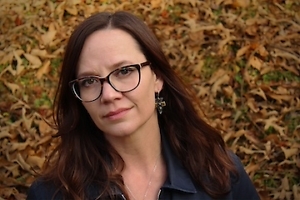A Runaway’s Story
Rachel M. Hanson’s memoir recounts her flight from abuse
There’s a scene in Rachel M. Hanson’s The End of Tennessee: A Memoir where Rachel, aged 15, is standing in the hallway of an East Tennessee theater where she is performing in La Sylphide, a romantic ballet that premiered in Paris in the 19th century.

She loves ballet, loves dancing en pointe, loves the way she is, for a short time, not stuck at home caring for younger siblings but “able to understand what it might be like to be my own person, to have agency, to be someone my mother was trying so hard to keep me from being.”
The hallway, with its black curtains, is a haven, “the only safe darkness I know.” At home, there is trouble. Her mother hits the children for no reason, while her father demands submission. “Over the years I was growing up, my father gripped me by the forearms so tightly I could feel the blood pulsating in my veins, trying hard to push past his fingertips. But he held fast, and held my eyes with his, trying to force me to look away, to look down.” She hated him for it.
Although her mother had pushed her into ballet to cure her of the rough-and-tumble personality she had adopted growing up in a houseful of brothers, she learns right after La Sylphide that her parents have cut off her dance lessons, despite generous teachers footing the bill. That leaves her no outlet, since they had long since cut off her formal education, deeming school out of sync with their ever-changing religious beliefs. Their homeschooling wasn’t much. Her mother keeps having babies, and Rachel’s job is to take care of them.
At home in the bathroom, she gulps down her mother’s pain pills, hoping they will kill her.
 Reminiscent of Tara Westover’s Educated and Jeannette Walls’ The Glass Castle, Hanson’s book is about a smart, talented teen girl seeking to escape a home defined by abuse and limited notions of what a young woman should do. The family homes — first in Texas, then Tennessee — are cramped and dirty. When she is 12, the family of eight lives in a two-bedroom trailer, eating popcorn for dinner. For several homeless months, they live in the car, traveling from place to place, staying with strangers her mother finds through churches.
Reminiscent of Tara Westover’s Educated and Jeannette Walls’ The Glass Castle, Hanson’s book is about a smart, talented teen girl seeking to escape a home defined by abuse and limited notions of what a young woman should do. The family homes — first in Texas, then Tennessee — are cramped and dirty. When she is 12, the family of eight lives in a two-bedroom trailer, eating popcorn for dinner. For several homeless months, they live in the car, traveling from place to place, staying with strangers her mother finds through churches.
As an adult, Hanson realizes the abuse and poverty are generational. Her maternal grandmother was raped days after giving birth, while her father “grew up eating meals made possible by taxpayers.” Although, despite his domination, she is more understanding of her father, she realizes he won’t follow through with promises to help her get an education. At 17, she runs.
Although I sometimes wished Hanson would summarize less and show us more scenes, the chapter titled “The End of Tennessee” is an exception. She takes us, moment by moment, into her escape — packing a small bag and hiding it, arranging a ride with a married brother, deciding where to go. Her mother discovers her plan and beats her, but she leaves anyway, taking a bus to Indiana where a ballet teacher who once promised to help has moved. She wants to get a job so as not to be a burden, but soon learns it’s not that easy. Back in Tennessee, her parents have notified the police. Since harboring a runaway is illegal, the kind woman who takes her in could be in trouble. Hanson doesn’t mention the dangers of sex trafficking, but reading this chapter, it’s easy to see how teen girls from abusive homes become victims.
Fortunately, Hanson is no victim. She makes her way, moving west to study ballet at the University of Utah, where she eventually earns three degrees — a bachelor’s in international studies and another in political science, plus an M.F.A. in creative writing. She earned a Ph.D. from the University of Missouri and is now an assistant professor at the University of North Carolina Asheville.
All this would seem to be a story with a happy ending — and in many ways it is. But the truth is she aches for the siblings she left behind, particularly her little sister, who begged to leave, too. And while the chapter about running away could have been the end of the book, Hanson shows us her life in Utah, where she has an on-again, off-again relationship with Jonah, a man who is inconsiderate of her needs. When she is raped by another man and has an abortion, Jonah wants sex soon after she gets home — a variation on her grandmother’s experience. “Afterwards, I wrapped up in a sheet to hide my insides shedding something like coffee grounds, like blood. A few months later I tried to leave him, and that’s when I realized that leaving didn’t come easy to me.”

Jane Marcellus is a Tennessee writer whose work includes critical analysis, journalism, and essays.


